Table of Contents
On April 22, 2025, the tranquillity of Pahalgam was shattered when Pakistan-backed terrorists stormed a village, asking civilians their religion before killing 26 innocents. This heinous act marked a dangerous shift in strategy—from cross-border attacks to attempts at communal destabilisation within India. In response, the Government of India launched Operation SINDOOR, a strategic and multi-dimensional operation to dismantle the terror infrastructure and send a clear message: India will not tolerate terrorism.
Operation Sindoor – Government and Army Press Briefing Summary
Indian Army, Indian Air Force and the Ministry of External Affairs conducted a joint press conference in New Delhi on Operation Sindoor. Addressing the media, Indian Army’s Colonel Sofia Qureshi and Indian Air Force’s Wing Commander Vyomika Singh reported that Operation Sindoor was initiated to bring justice to the victims of the Pahalgam terror attack.
- India launched Operation Sindoor in the early hours of May 7, 2025, targeting terrorist camps in Pakistan and Pakistan-occupied Jammu & Kashmir (PoJK).
- 9 terrorist infrastructure sites linked to banned outfits like Lashkar-e-Taiba, Jaish-e-Mohammed, and Hizbul Mujahideen were precisely struck.
- The Indian government clarified that no Pakistani military installations were targeted—only non-state terror elements.
- Operation Sindoor was a retaliatory strike for the April 22, 2025, Pahalgam terror attack, where 26 Indian civilians (mostly tourists) were brutally killed.
- The attackers in Pahalgam were identified as Pakistan-based terrorists. Victims were killed in front of family members to instil fear and disrupt peace.
- The government accused Pakistan of having a well-documented record as a haven for terrorism.
Over the Last Decade
- 350+ Indian civilians have been killed in cross-border terrorism.
- 800+ injured, and 600+ security personnel martyred.
- The government said, “No more” – India will not tolerate further attacks.
What is OPERATION SINDOOR?
OPERATION SINDOOR is the name given by the Indian Armed Forces to the retaliatory precision strikes carried out on Wednesday, May 7, 2025, against terrorist infrastructure in Pakistan and Pakistan-occupied Kashmir (PoK). This operation was a direct response to the deadly terror attack in Pahalgam, Jammu & Kashmir, on April 22, 2025, which resulted in the deaths of 26 civilians.
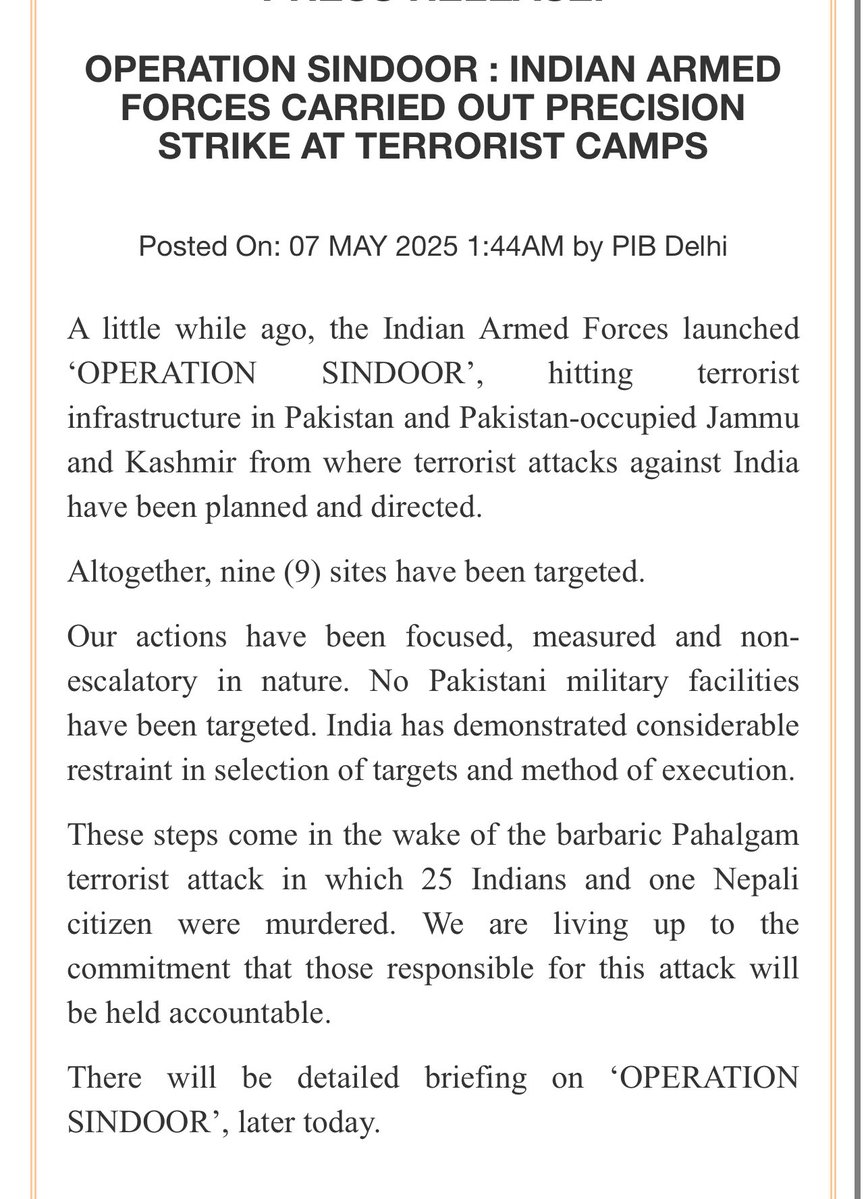
Purpose of Operation SINDOOR
- To punish perpetrators and planners of the Pahalgam terror attack
- To dismantle terror infrastructure operating across the border
- To re-establish India’s deterrence against future threats
Nine Terror Sites Targeted Under Operation Sindoor
According to official sources, nine terror camps were destroyed — 4 located inside Pakistan and 5 within PoJK.
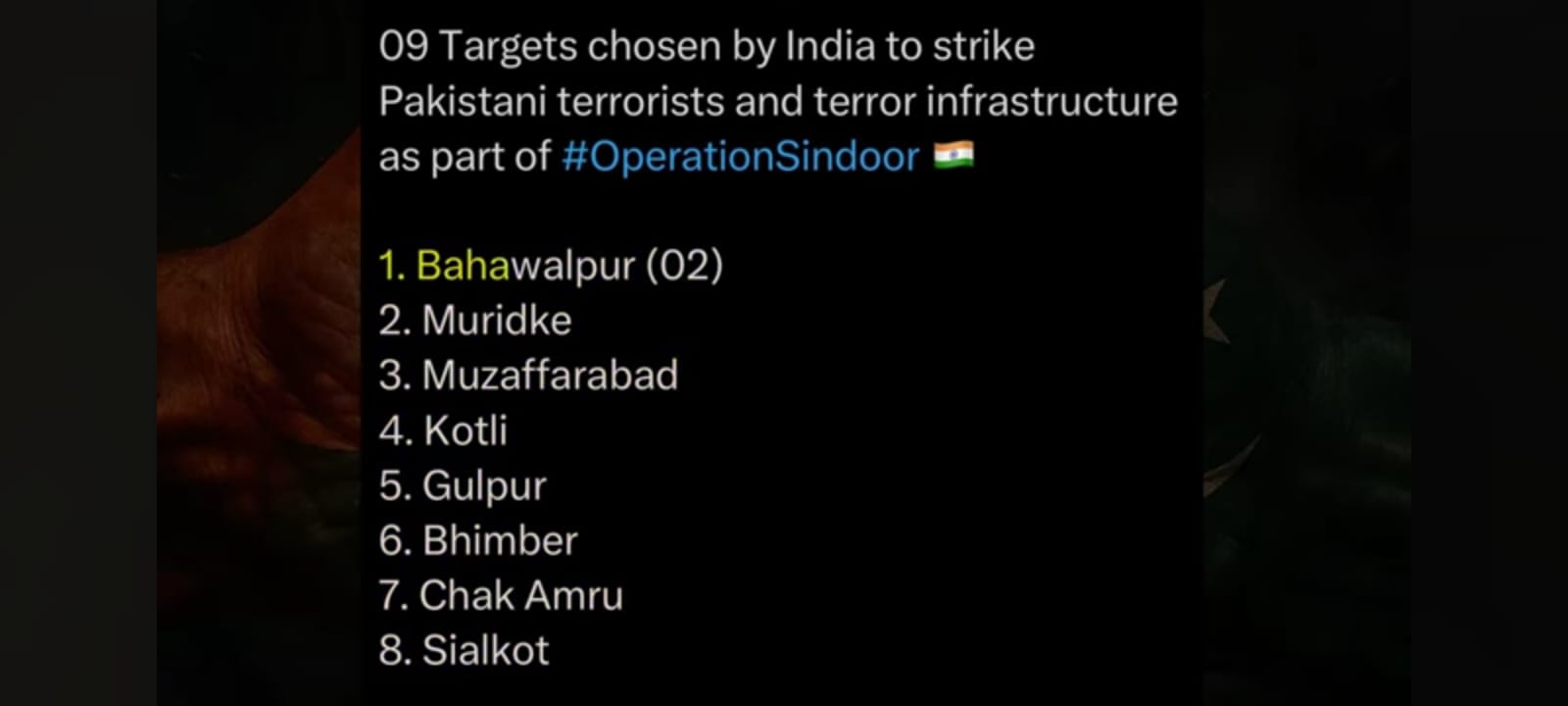
Confirmed Targets in Pakistan
- Markaz Subhan Allah, Bahawalpur – Jaish-e-Mohammed HQ
- Markaz Taiba, Muridke – Lashkar-e-Taiba base
- Mehmoona Joya, Sialkot – Hizbul Mujahideen camp
- Markaz Ahle Hadith, Barnala – LeT linked religious-indoctrination hub
Confirmed Targets in PoJK
- Syedna Bilal Camp, Muzaffarabad – Jaish training centre
- Shwawai Nalla Camp, Muzaffarabad – LeT operations unit
- Makaz Raheel Shahid, Kotli – Hizbul Mujahideen centre
- Markaz Abbas, Kotli – JeM safehouse
- Sarjal Facility, Tehra Kalan – weapons & IED storage
Terrorist Camps in PoJK and Pakistan
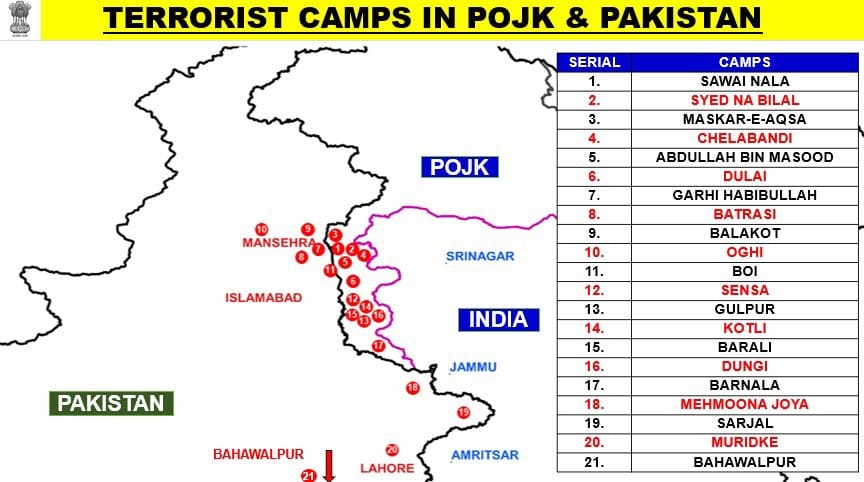
Key Highlights of OPERATION SINDOOR
- Target: Nine terror-associated sites were attacked, including the offices of Jaish-e-Mohammed (JeM) in Bahawalpur and Lashkar-e-Taiba (LeT) in Muridke.
- Forces Used: A joint effort by the Indian Army, Indian Navy, and Indian Air Force.
- Method: Advanced precision strike weapon systems were employed, with attacks launched from Indian territory.
- Nature: The operation was termed “focused, measured, and non-escalatory,” with no Pakistani military installations attacked.
- Rationale: India reported that it was implementing its pledge to bring those culpable for the Pahalgam attack to justice.
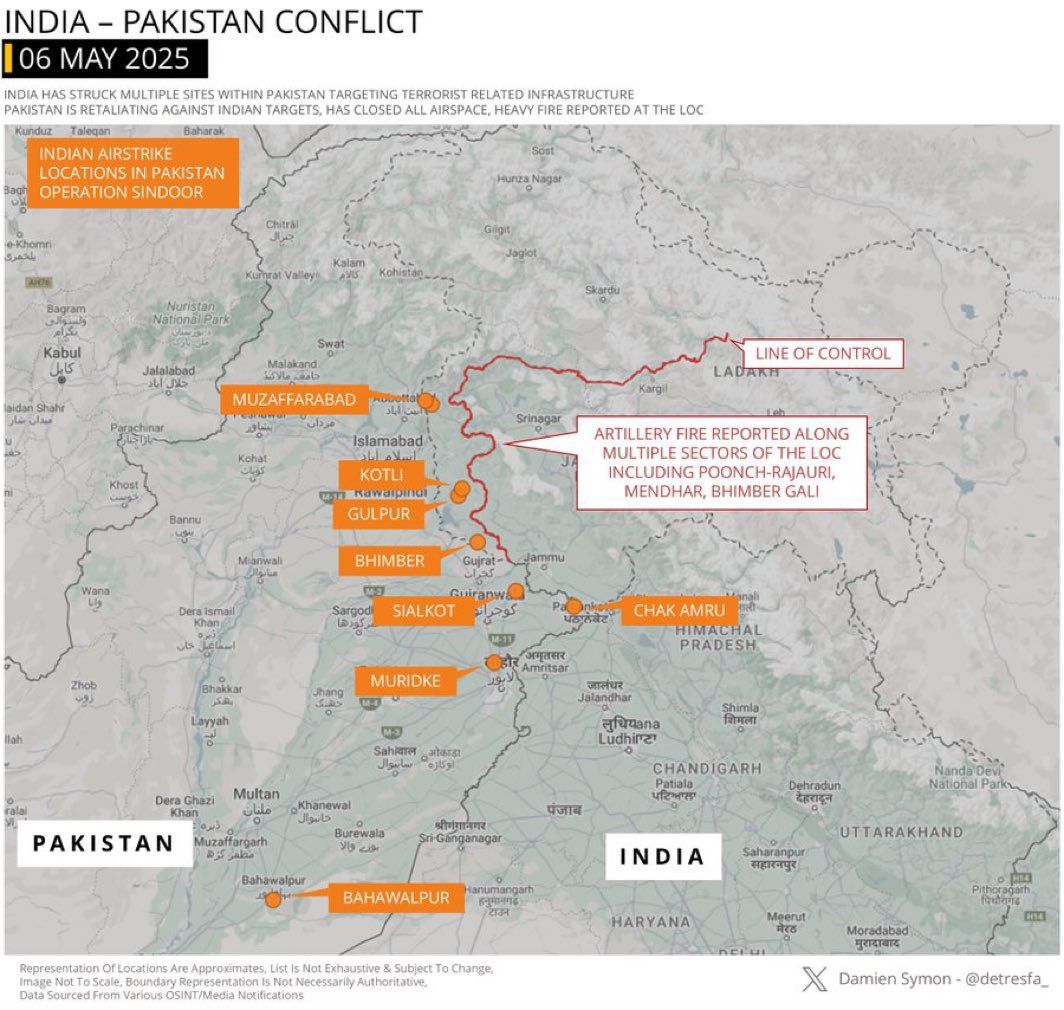
Pakistan has cleared its airspace following India’s Operation Sindoor mission that hit nine locations. This followed after explosions were heard in various cities, including Muzaffarabad and Bahawalpur. The report further stated that power was blacked out in Muzaffarabad.
It said Indian armed forces’ actions have been focused, measured and non-escalatory in nature, adding that “no Pakistani military facilities have been targeted. India has demonstrated considerable restraint in the choice of targets and the method of implementation.”
Significance of OPERATION SINDOOR
Operation SINDOOR is a major escalation of India’s reaction to cross-border terrorism and is said to be the first time since the 1971 Indo-Pak war that all three branches of the Indian military have cooperated to strike targets within Pakistan. The name “Sindoor,” a Hindi term for the vermilion that married Hindu women wear, is said to represent national mourning and determination, especially for the couples who were targeted in the Pahalgam attack.
Pakistan’s Response After Operation
1. Civilian Casualties
Pakistan’s Foreign Ministry claimed that eight civilians were killed and 35 others were injured, including women and children, as a result of the missile strikes. The Pakistani army also alleged that Indian missiles targeted civilian areas in cities like Sialkot and Muzaffarabad. However, India rejected these claims, reiterating that only terror camps were struck.
2. Military Retaliation
-
After India’s strikes, Pakistan resorted to artillery shelling and firing across the Line of Control (LoC) and the International Border (IB), leading to heightened tensions along the border.
-
Three Indian civilians were reported killed in the Pakistani shelling. India’s military responded proportionately.
3. Pakistan Claims to Have Shot Down Indian Jets
In a significant escalation, Pakistan claimed to have shot down five Indian jets:
-
Three Rafale aircraft
-
One SU-30
-
One MiG-29
This claim was later confirmed by Pakistani officials, who also stated that Indian pilots had been captured. However, these claims have not been independently verified by India.
4. Statements from Pakistan’s Leadership
Pakistani leaders condemned India’s military actions, with Prime Minister Shehbaz Sharif calling it a “cowardly attack”. Pakistan reserved the right to respond decisively to what it termed as an unprovoked attack.
Defence Minister Khawaja Asif stated, “We will respond if India attacks, but if they back down, we will de-escalate.”
Impact on Civilian Life and Flights
Amid rising tensions, flight operations in northern India were severely affected:
- Air India, Air India Express, and SpiceJet cancelled or diverted flights to and from Jammu, Srinagar, Leh, Amritsar, and several other cities.
- Airports in these regions were temporarily closed, and flights were disrupted until further notice.
Global Reactions and Geopolitical Implications
-
International Concern: The international community has expressed concern over the rising tensions between India and Pakistan, urging both sides to de-escalate and engage in dialogue.
-
US and UN Responses: The United States and the United Nations have urged restraint and called for peace to be maintained in the region, fearing that the situation could escalate into a larger conflict.
Conclusion
Operation Sindoor marks a significant shift in India’s approach to counter-terrorism. By targeting terrorist infrastructure in Pakistan and PoK, India has sent a strong message about its resolve to act against terror groups operating on its borders. However, the operation has also led to heightened tensions, with Pakistan responding militarily and claiming civilian casualties.
As the situation unfolds, global observers will be watching closely to see if this escalation can be contained or if it leads to a larger military conflict. For now, the focus remains on the safety and security of civilians, the need for diplomatic channels to remain open, and the importance of international efforts to avoid further escalation in the already volatile region.

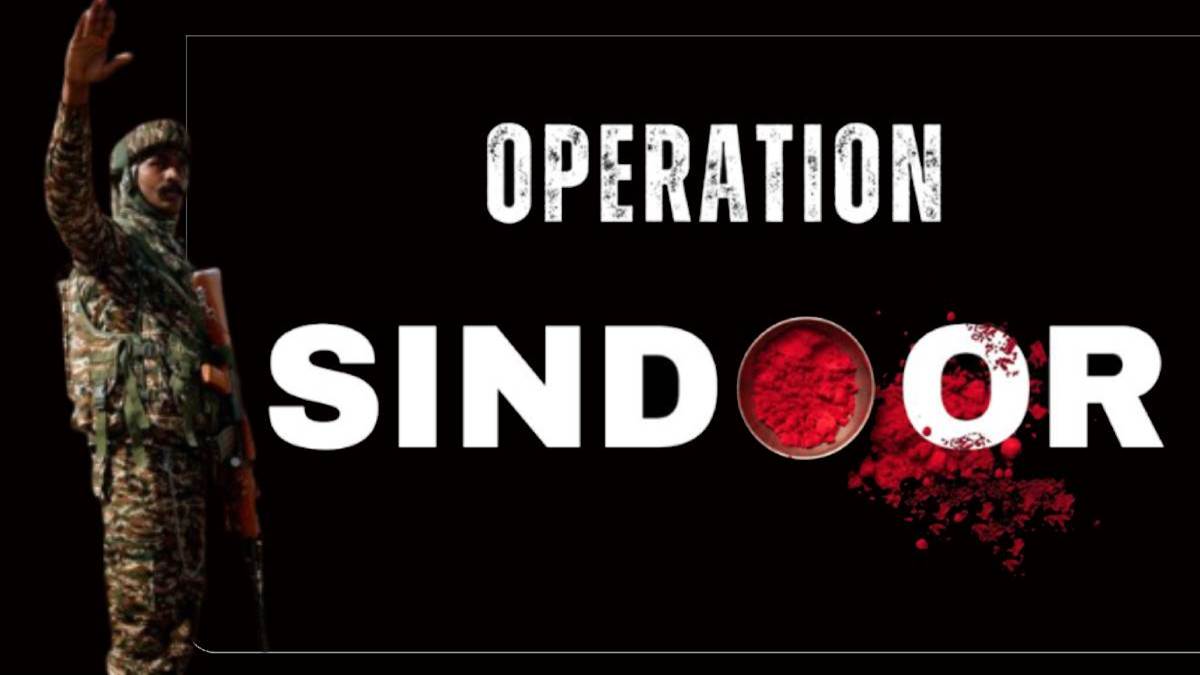
 Theaterisation of the Indian Armed Force...
Theaterisation of the Indian Armed Force...
 Industrial Accidents in India: Reasons, ...
Industrial Accidents in India: Reasons, ...
 S-400 Missile Defence System, Features o...
S-400 Missile Defence System, Features o...

























